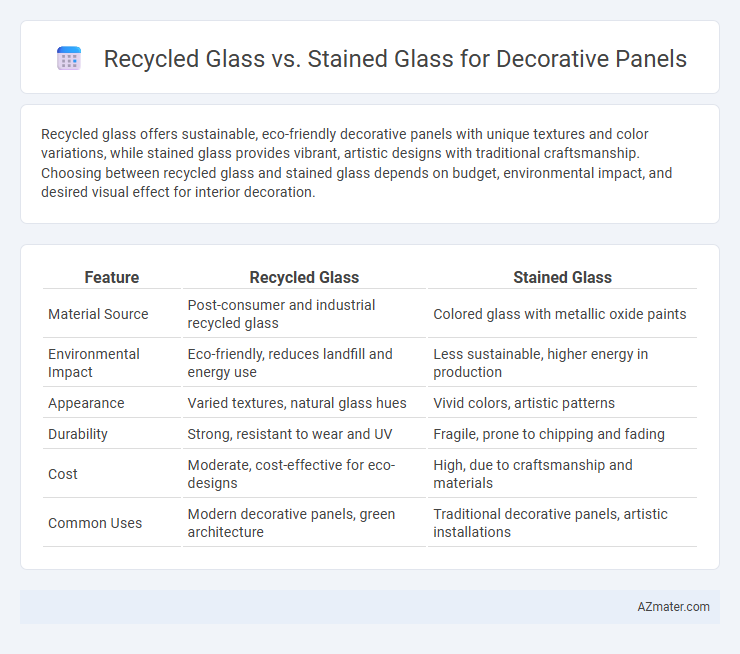Recycled glass offers sustainable, eco-friendly decorative panels with unique textures and color variations, while stained glass provides vibrant, artistic designs with traditional craftsmanship. Choosing between recycled glass and stained glass depends on budget, environmental impact, and desired visual effect for interior decoration.
Table of Comparison
| Feature | Recycled Glass | Stained Glass |
|---|---|---|
| Material Source | Post-consumer and industrial recycled glass | Colored glass with metallic oxide paints |
| Environmental Impact | Eco-friendly, reduces landfill and energy use | Less sustainable, higher energy in production |
| Appearance | Varied textures, natural glass hues | Vivid colors, artistic patterns |
| Durability | Strong, resistant to wear and UV | Fragile, prone to chipping and fading |
| Cost | Moderate, cost-effective for eco-designs | High, due to craftsmanship and materials |
| Common Uses | Modern decorative panels, green architecture | Traditional decorative panels, artistic installations |
Introduction to Decorative Glass Panels
Decorative glass panels enhance interior and exterior design by combining aesthetics with functionality, utilizing materials such as recycled glass and stained glass. Recycled glass offers eco-friendly benefits with unique textures and color variations from repurposed materials, promoting sustainability in architectural applications. Stained glass provides rich, vibrant hues and intricate patterns created through traditional techniques, contributing timeless artistic value to decorative installations.
Overview of Recycled Glass Decorative Panels
Recycled glass decorative panels leverage crushed glass from post-consumer and industrial sources, offering an eco-friendly alternative that reduces landfill waste and conserves natural resources. These panels exhibit high durability, resistance to stains and scratches, and a unique, textured aesthetic that enhances interior design with vibrant color variations. Compared to stained glass, recycled glass panels often provide superior thermal and acoustic insulation properties while promoting sustainable building practices.
Understanding Stained Glass: History and Techniques
Stained glass, a centuries-old art form dating back to medieval Europe, involves coloring glass by adding metallic salts during its molten state, producing vibrant hues and intricate designs used in decorative panels. Traditional techniques include painting with vitreous paint for detail, leading, and copper foil methods to assemble multiple pieces into complex images or patterns. Understanding these historical methods highlights stained glass's unique artistic value compared to recycled glass, which emphasizes sustainability and raw material reclamation but lacks the same nuance in craftsmanship and color vibrancy.
Sustainability Comparison: Eco-Friendliness of Both Materials
Recycled glass panels significantly reduce environmental impact by repurposing post-consumer waste and lowering energy consumption during production compared to traditional stained glass. Stained glass often requires raw materials and energy-intensive processes like lead came assembly, which increase its carbon footprint. Choosing recycled glass for decorative panels promotes sustainability through waste reduction and more efficient resource use, making it the eco-friendlier option.
Aesthetic Differences: Visual Impact and Color Options
Recycled glass panels offer a distinctive, eco-friendly appeal with subtle, varied textures and a natural, often muted color palette that enhances earthy or modern minimalist aesthetics. Stained glass provides vibrant, richly saturated colors and intricate designs, creating dramatic visual impact and allowing for detailed storytelling or traditional artistry in decorative panels. Choosing between recycled and stained glass depends on the desired ambiance, with recycled glass lending contemporary elegance and stained glass delivering timeless, colorful brilliance.
Durability and Maintenance Considerations
Recycled glass decorative panels offer superior durability due to their resistance to scratches, impact, and UV damage, making them ideal for high-traffic areas with minimal maintenance. Stained glass requires regular cleaning and careful handling to prevent paint fading, lead deterioration, and cracking, which can compromise its longevity. Both materials can be sealed for added protection, but recycled glass panels generally provide a more robust and low-maintenance solution for long-term decorative use.
Customization and Design Flexibility
Recycled glass offers high customization and design flexibility through its variety of colors, textures, and sizes, allowing for unique, eco-friendly decorative panels tailored to specific aesthetic preferences. Stained glass provides intricate, traditional designs with vibrant color transitions achieved by hand-painting and leading techniques, ideal for artistic and detailed panels. Both materials enable personalized creations, but recycled glass excels in modern, modular design options, while stained glass remains unmatched in classic, handcrafted artistry.
Cost Analysis: Budgeting for Each Glass Type
Recycled glass panels offer a cost-effective solution due to lower material expenses and reduced manufacturing energy requirements, making them ideal for budget-conscious projects. Stained glass typically involves higher costs from intricate craftsmanship and custom coloration, increasing overall installation and maintenance expenses. When budgeting for decorative panels, factoring in material durability and long-term upkeep can further influence the cost comparison between recycled and stained glass options.
Suitability for Home and Commercial Spaces
Recycled glass panels offer eco-friendly durability and a unique, textured aesthetic ideal for sustainable home interiors and modern commercial spaces seeking environmental credentials. Stained glass provides intricate color patterns and classical elegance, making it suitable for decorative features in traditional homes and upscale commercial venues requiring artistic appeal. Both materials enhance light diffusion, but recycled glass excels in contemporary, minimalist designs while stained glass suits ornate, historic, or themed environments.
Choosing the Right Glass for Your Decorative Panel Project
Recycled glass offers an eco-friendly and cost-effective option for decorative panels, featuring unique textures and a sustainable appeal that reduces environmental impact. Stained glass provides vibrant colors and intricate designs, enhancing aesthetic value and historical charm ideal for artistic or traditional projects. Choosing the right glass depends on your project's budget, design complexity, and sustainability goals.

Infographic: Recycled glass vs Stained glass for Decorative panel
 azmater.com
azmater.com